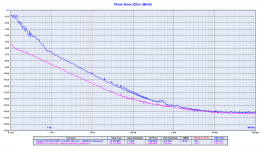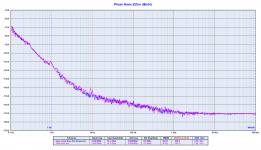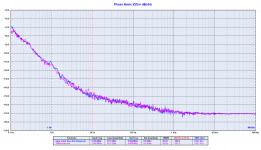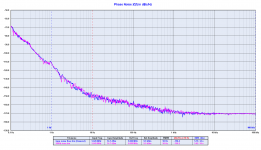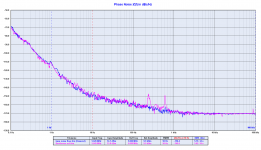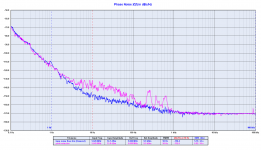At most frequencies you can see the driscoll has lower noise at HF, and bit lower in LF too, I would choose driscoll for that.
LF noise is most important, but does HF noise matter at all?
Its only for 22Mhz they are pretty much identical (This is only oscillator freq. I will get)
LF noise is most important, but does HF noise matter at all?
Its only for 22Mhz they are pretty much identical (This is only oscillator freq. I will get)
As I said several times the most important is the close in phase noise, the noise floor does not matter unless it was exaggerated.
The Crystek CCHD-957 has better noise floor than the Oscilloquartz BVA 8607, so why you can get the Crystek from the shelf for a few bucks while to get the BVA you had to wait months and pay several thousands of dollars?
The Crystek CCHD-957 has better noise floor than the Oscilloquartz BVA 8607, so why you can get the Crystek from the shelf for a few bucks while to get the BVA you had to wait months and pay several thousands of dollars?
Hello Andrea and i hope everything is fine with you.
Really great work. Bravo.
Well, as u know, there are a few reasons why BVA8607 is expensive and Crystek CCHD is not:
- They address different segments of the market.
- The sales volume is very low on the part of BVAxxx.
- Customers for BVAxxx are mostly companies, not private people.
- There are a lot of specialized mechanical/electrical solutions to guarantee PN data under all conditions = this costs money
- Although still important, EXTREMELY low close-in PN is not a prime-objective in telecommunication.
I am still not sure about the effects of insanely low close-in PN on the perceived sound of DACs, but your efforts - as I have mentioned before - is very much appreciated.
Bravo again.
Cheers
Really great work. Bravo.
Well, as u know, there are a few reasons why BVA8607 is expensive and Crystek CCHD is not:
- They address different segments of the market.
- The sales volume is very low on the part of BVAxxx.
- Customers for BVAxxx are mostly companies, not private people.
- There are a lot of specialized mechanical/electrical solutions to guarantee PN data under all conditions = this costs money
- Although still important, EXTREMELY low close-in PN is not a prime-objective in telecommunication.
I am still not sure about the effects of insanely low close-in PN on the perceived sound of DACs, but your efforts - as I have mentioned before - is very much appreciated.
Bravo again.
Cheers
Last edited:
In radio basestations the oscillators has always been critical - even more so as the frequencies are raised and the modulation schemes gets tighter and tighter. Also, here there are requirement on withstanding vibration - many a subway have wrecked what some cell planner thought was a safe bid. Saying that....
I would like to see vibration adressed as an potential problem and wish to see a measurement from Andrea:
Set up the same measurement as one of the latest 22,5 MHz but play pink noise from at least 1 meter distance for 85 dB at (1 kHz; +/- 3 dB 20-20k?) the location of the Driscoll.
Compare to previous silent situation.
//
I would like to see vibration adressed as an potential problem and wish to see a measurement from Andrea:
Set up the same measurement as one of the latest 22,5 MHz but play pink noise from at least 1 meter distance for 85 dB at (1 kHz; +/- 3 dB 20-20k?) the location of the Driscoll.
Compare to previous silent situation.
//
Hello all.
I think sound waves in the listening room might affect the PN of any oscillator (inside CD players, dacs a.s.o).
However:
I don't think it is something that Andrea needs to address since mechanical stability always costs TIME & money and it is something that can be taken care of by the individual diy:er.
For example placing oscillator PCB inside heavily damped, floating enclosures, or magnetic and electric shielding, etc.
I have seen on the net examples of oscillators placed inside a thick shielded copper box, this then placed inside a heavy iron enclosure, floating on a fairly sophisticated arrangement of loose springs and big rubber rings floating in x-y-z plane.
Like anything else, mechanical damping can be taken to the extreme Maybe not something Andrea needs to think about....but that's just my opinion.
Maybe not something Andrea needs to think about....but that's just my opinion.
Cheers
I think sound waves in the listening room might affect the PN of any oscillator (inside CD players, dacs a.s.o).
However:
I don't think it is something that Andrea needs to address since mechanical stability always costs TIME & money and it is something that can be taken care of by the individual diy:er.
For example placing oscillator PCB inside heavily damped, floating enclosures, or magnetic and electric shielding, etc.
I have seen on the net examples of oscillators placed inside a thick shielded copper box, this then placed inside a heavy iron enclosure, floating on a fairly sophisticated arrangement of loose springs and big rubber rings floating in x-y-z plane.
Like anything else, mechanical damping can be taken to the extreme
Cheers
Last edited:
I think sound waves in the listening room might affect the PN of any oscillator (inside CD players, dacs a.s.o).
Right, I tested in the 199x the CD players with the following, knowing the base freq of the crystal:
- use a world UKW receiver
- set the frequency about 3 or 5 times the crystal freq.
- switch the CD player on and some noise should be listenable
- play music and listen to the radio
While in the old days, the crystal was usual connected to the single CD control IC...
Hp
I have seen papers documenting the effects of vibration-induced PN. It appears to be quite measurable.
In the mid 90's I also did some (very simple) tests, where I placed the DAC (Mclk inside dac) underneath the left speaker, and then
listened to loud music.
But I admit dampening the DAC enclosure (with clock inside) actually improved the perceived sound-stage, so maybe
that might be more interesting for people here to know.
Cheers.
In the mid 90's I also did some (very simple) tests, where I placed the DAC (Mclk inside dac) underneath the left speaker, and then
listened to loud music.
But I admit dampening the DAC enclosure (with clock inside) actually improved the perceived sound-stage, so maybe
that might be more interesting for people here to know.
Cheers.
Hi W. Good to hear from you here.
Well, maybe Andrea can provide answers to that proposal, but I don't think it provides any additional insight or information to his designs.
No provisions are made in Andrea clocks to address vibration-induced phase noise, at least afa I know.
cheers
Well, maybe Andrea can provide answers to that proposal, but I don't think it provides any additional insight or information to his designs.
No provisions are made in Andrea clocks to address vibration-induced phase noise, at least afa I know.
cheers
Last edited:
Its about helping the end user all the way to the finish. To get all the way to the music. What is the use of a good dBc/Hz if you lose it in the way?
Some report no gain when "upgrading" clock - maybe its due to mechanical feedback ala record player but from the 21st century.
I have a hunch that this might be a real problem but I'm unsure - would be nice with someone with the adequate measuring gear to verify how it is. So, yes, pretty please?
//
Some report no gain when "upgrading" clock - maybe its due to mechanical feedback ala record player but from the 21st century.
I have a hunch that this might be a real problem but I'm unsure - would be nice with someone with the adequate measuring gear to verify how it is. So, yes, pretty please?
//
I have alredy suggested a way to reduce vibrations impact and to get a better thermal stability in post #2808
The Well Tempered Master Clock - Building a low phase noise/jitter crystal oscillator
Anyway we have already measured the impact of vibrations on the phase noise of the oscillator.
I will publish the plots as soon as I find them.
The Well Tempered Master Clock - Building a low phase noise/jitter crystal oscillator
Anyway we have already measured the impact of vibrations on the phase noise of the oscillator.
I will publish the plots as soon as I find them.
Someone did ask me to publish the phase noise plot of the Crystek CCHD-957 down to 0.1 Hz from the carrier.
I attach the plot compared to the cheap TWTMC-PPG at the same frequency, I had to change the dBc scale to show the phase noise of the Crystek at 0.1 from the carrier.
Maybe after hours of measurement it could perform a little better, this measurements was 30 minutes long (even the measurement of the TWTMC-PPG).
I attach the plot compared to the cheap TWTMC-PPG at the same frequency, I had to change the dBc scale to show the phase noise of the Crystek at 0.1 from the carrier.
Maybe after hours of measurement it could perform a little better, this measurements was 30 minutes long (even the measurement of the TWTMC-PPG).
Attachments
The following measurements was done in 2020 March with an older version of the new Driscoll oscillator at 5.6448MHz.
The oscillator was shielded in the aluminum box but was not yet decoupled with damping material as suggested in post #2808.
The condition was almost extreme:
- 90dB and more of sound level
- oscillator box placed at a distance of a few cm from the bass driver on a wooden tablet that rests on the speaker box
- no damping material was used
It was sufficient to move the oscillator box 50 cm away from the speaker to make the spurious disappear almost completely.
But keep in mind that even the moving air can affect the close in phase noise performance.
This is diy, everyone will try to find his best way to reduce the effect of the vibrations.
The oscillator was shielded in the aluminum box but was not yet decoupled with damping material as suggested in post #2808.
The condition was almost extreme:
- 90dB and more of sound level
- oscillator box placed at a distance of a few cm from the bass driver on a wooden tablet that rests on the speaker box
- no damping material was used
It was sufficient to move the oscillator box 50 cm away from the speaker to make the spurious disappear almost completely.
But keep in mind that even the moving air can affect the close in phase noise performance.
This is diy, everyone will try to find his best way to reduce the effect of the vibrations.
Attachments
Last edited:
Driscoll and Differential oscillators have almost the same phase noise at all frequencies, so there are no other parameters to influence the choice.
The only way could be listening to both in the same system and then make the choice according to personal taste.
WRT Driscoll vs Differential:
I think it's worth comparing sub harmonics between differential and Driscoll. Many here will be using them for DS type DACs and as pointed out, some DS
DACs have varying sensitivity to the oscillators sub harmonics.
Also it's worth noting that if there is equal amplitude of H2/3 and H1/3 this will result in cancellation of sub harmonic induced jitter on rising edges.
Just a thought if there is nothing else to sway the decision.
TCD
- Status
- Not open for further replies.
- Home
- Source & Line
- Digital Line Level
- The Well Tempered Master Clock - Building a low phase noise/jitter crystal oscillator
